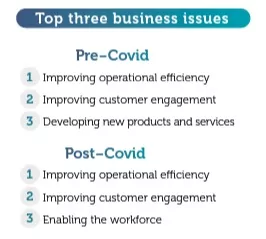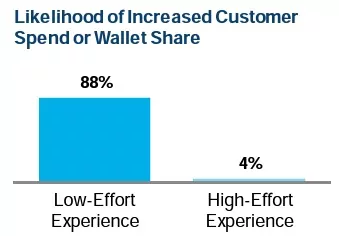The digital customer experience is crucial to a business’s success.
Consumers have never had more choices as to who they do business with. If your digital customer experience is frustrating, customers will have no hesitation in abandoning you for another brand.
The more engaging and encompassing your digital environment is, the more attractive it will be to customers.
Improving customer engagement has long been a top priority for businesses. According to the 2020 Harvey Nash Survey, it ranks second for both pre-and post-covid priorities.

Source: KPMG
In 2020, many businesses had to make a sudden shift in their business model in response to the global pandemic. This made the online environment even more critical as customers relied on digital platforms to access the products and services they needed.
In 2022, the emphasis on improving the digital experience remains. We are going to explore how you can track the digital experience for your customers and improve it.
Key Takeaways
- The digital customer experience includes all online interactions a customer will have with your brand.
- Identifying key customer personas and journeys shows you where you should focus your resources.
- You can use metrics such as Net Promotor Score to track the digital customer experience.
- Advanced technology, including AI and automation, can enhance the digital customer experience.
What Is the Digital Customer Experience?
The digital customer experience includes all interactions a customer has with your brand online. It usually includes your company website, social media accounts, and other digital touchpoints that interact with your customers.
How to Track the Digital Customer Experience
You want to have complete visibility into the customer experience. Ideally, you should know every time a customer clicks a link, scrolls past your page, and adds an item to their cart. Being able to track your customer’s preferences and behaviors can lead to more immersive, customizable customer experiences.
Before you can begin tracking and measuring the impact of the digital customer experience, you need to do the following:
- Identify which customer experiences you want to measure: While you may want to follow the path of every single customer, that is not always feasible. Instead, you need to identify your core customer base that has the biggest effect on your business. You want to optimize the digital experience for those customers.
- Choose key touchpoints: Ideally, you want a seamless, stress-free digital experience across all channels. While this should be your goal, if you are just starting out, focus on the most important touchpoints and start making improvements from there.
- Identify which metrics have the biggest impact on your business: There are numerous metrics a business can use to track the customer experience. However, not all metrics are equally important to all businesses. Some will need to prioritize attracting new customers, while others want to reduce the number of abandoned carts. Focus on the metrics that matter to your company.
Many businesses have turned to advanced, real-time tracking software with AI technology to expose pain points and show where and how customers are interacting with you online.
Metrics for Tracking DCX
Trackable customer data gives you a good understanding of how the customer experience is changing. The three metrics below offer an insight into how customers perceive and interact with your brand.
- Customer Satisfaction (CSAT)
The Customer Satisfaction metric measures how satisfied a customer feels with a product or service.
Businesses frequently use CSAT to understand how customers feel after buying a product or experiencing a service. For example, you could send customers a quick survey after making a purchase on your website, asking them to rate their experience from 1 to 10.
To get the full picture of the digital customer experience, you should offer surveys at each touchpoint within the customer journey.
Asking follow-up questions, like “Why did you choose that rating?” or asking for general suggestions can give you specific areas to work on.
- Customer Effort Score (CES)
The CEB Analysis shows that low-effort experiences lead 88% of customers to spend more. Findings like this show that reducing the amount of effort required to do business with you has a direct correlation to how much customers are willing to spend.
Source: CEB
Use the Customer Effort Score (CES) to gauge how much effort it takes for customers to use your digital channels. You can offer a CES survey when a customer completes a purchase or interacts with digital customer support.
The results from these surveys can expose pain points for your customers.
- Net Promoter Score (NPS)
This metric is used by companies all around the world to understand how engaged their customers are. It includes two simple questions:
- How likely are you to recommend our company or services to others?
- What made you choose that score?
The NPS is on a scale from 0-10, where 10 represents an engaged and satisfied customer who is willing to share their experiences with others.
Historically, the NPS survey can be a good predictor of future growth. As your score goes up, you can generally expect an increase in revenue, too.
Businesses also track other metrics like customer retention rates, brand equity, and service costs.
How to Improve the DCX
With trackable data, your business can visualize customer interactions and perceptions. You can use that data to make necessary improvements to the customer experience.
Before you jump into making changes, you should go through this four-step process:
- Fully understand each customer journey: Put yourself in your customers’ position. What do you experience when you try to interact with your brand? What kind of emotions do you feel?
- Identify your audience: What kind of characteristics do your customers have in common? Create customer personas for your most common customer types.
- Make it easy for customers to offer feedback: Your customers are the best source of information about the customer experience. Use them to your advantage by asking for their feedback.
- Monitor high-level problems with the digital experience: When you know which customer journeys are the most common, you can focus your efforts on resolving problems within those journeys.
For a look at the future of the digital customer experience, watch this video from Steven Van Belleghem.
Automation Can Improve the Digital Customer Experience
While you may wish you could manually be with each customer through every part of the customer journey, that is not possible. However, with an automated system, your customers may feel like you are there supporting them every step of the way.
At MXTR, we offer advanced automation solutions that can take some of the stress out of your marketing protocols. We use automated email marketing that reacts to customer actions so they get the right message at the right time. This can help improve their digital customer experience by making them feel more engaged with your brand.
Want to see MXTR in action? Schedule a demo to see how MXTR marketing automation can enhance the digital customer experience.
Featured Image: istockphoto








